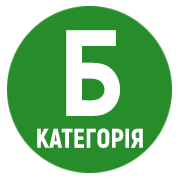ORGANIC FARMING AS A MECHANISM FOR SUSTAINABLE FOOD PRODUCTION
Abstract
In recent years, agriculture has caused a number of negative consequences for the environment, negatively affecting the current state of ecosystems. Agriculture is one of the industries that pollutes the environment the most. As a result of growing crops, a large number of polluting chemicals enter the environment, which have a destructive effect on natural ecosystems. Therefore, organic farming is currently being developed, which is designed to reduce the negative impact of the agricultural industry on the environment and ensure sustainable food production. Therefore, the purpose of the article was to conduct a detailed analysis of organic farming as a key mechanism for ensuring sustainable food production. The study is based on the analysis of scientific sources, regulatory legal acts, statistical data and the experience of agricultural enterprises. First, the essence of organic farming as a leading trend in the development of agriculture at the present stage was analyzed. Historical aspects of the development of organic farming were established. Key differences of organic farming were identified. Its main features as an important component of modern agriculture have been identified. Based on the analysis of statistical data, it has been determined that the current state of organic farming in Ukraine is negative, as this industry is underdeveloped. Key trends in the development of organic farming at the current stage have been identified. The leading features of organic farming as an important component of sustainable food production have been identified. The findings obtained through the comprehensive analysis underscore that organic farming represents a fundamental component of contemporary agricultural systems and serves as a cornerstone for the advancement of sustainable food production practices. Organic farming is not merely an alternative but a strategic approach to addressing critical challenges in environmental preservation, soil fertility, and biodiversity conservation, which are integral to the resilience of agricultural ecosystems. In the context of Ukraine, addressing current obstacles, including regulatory gaps, insufficient infrastructure, and limited public awareness regarding the benefits of organic farming, holds paramount importance for fostering its progressive development.
References
Ткачук В. І. Ефективність виробництва органічної продукції у сільськогосподарських підприємствах. Ефективна економіка. 2015. № 11.
Шарий Г., Нестеренко С., Щепак В. Організація виробництва на підприємствах органічного землеробства. Аграрна економіка. 2021. № 1-2. Т. 14. С. 75–81.
Сенишин О. С. Формування стратегічних напрямів розвитку органічного землеробства в Україні з використанням методики SWOT-аналізу. Економіка і суспільство. 2017. № 10. С. 112–120.
Цилюрик Р. А. Органічне землеробство як елемент органічного сільськогосподарського виробництва: теоретико-правові засади. Порівняльно-аналітичне право. 2017. № 6. С. 180–183.
Багорка М. О., Юриченко Н. І. Обґрунтування процесу переходу агропідприємств на органічне виробництво та заходи практичної реалізації концепції екологічного маркетингу. Проблеми сучасних трансформацій. 2024. № 11.
Центр прикладних досліджень в енергетиці. Органічне землеробство. URL: https://www.ensave.org/organichne-zemlerobstvo
Дорош О. С., Сохацька М. Світові тенденції ведення органічного землеробства. 2023. URL: https://www.researchgate.net/publication/369338244_SVITOVI_TENDENCII_VEDENNA_ORGANICNOGO_ZEMLEROBSTVA
Верховна Рада України. Закон України «Про основні принципи та вимоги до органічного виробництва, обігу та маркування органічної продукції». 2018. URL: https://zakon.rada.gov.ua/laws/show/2496-19#n596
Агроперспектива. Площа сільськогосподарських угідь в Україні з органічним статусом – 246 126 га. 2024. URL: https://www.agroperspectiva.com/ru/news/190826
Avelife. Майбутнє органічного землеробства. URL: https://avelife.pro/майбутнє-органічного-землеробства-т/
EOS Data Analytics. Стале Сільське Господарство: Методи Та Їх Переваги. 2024. URL: https://eos.com/uk/blog/stale-silske-hospodarstvo/
Vakulenko V., Xiaowei L. (2022) Formation of information support system for the management of agricultural enterprises. Economics & Education, no. 7(3), pp. 6–11.
Вакуленко В. Л. Особливості впливу державної політики на розвиток аграрного сектору економіки. Науковий вісник Ужгородського національного університету. Серія: міжнародні економічні відносини та світове господарство. 2018. Випуск 21 (1). С. 35–37.
Tkachuk, V. I. (2015). Efektyvnist vyrobnytstva orhanichnoi produktsii u silskohospodarskykh pidpryiemstvakh [Efficiency of organic production in agricultural enterprises]. Efektyvna ekonomika – Efficient economy, vol. 11.
Sharyi, H., Nesterenko, S., Shchepak, V. (2021). Orhanizatsiia vyrobnytstva na pidpryiemstvakh orhanichnoho zemlerobstva [Organization of production at organic farming enterprises]. Ahrarna ekonomika – Agrarian economy, vol. 1-2 (14), pp. 75–81.
Senyshyn, O. S. (2017). Formuvannia stratehichnykh napriamiv rozvytku orhanichnoho zemlerobstva v Ukraini z vykorystanniam metodyky SWOT-analizu [Formation of strategic directions for the development of organic farming in Ukraine using the SWOT analysis methodology]. Ekonomika i suspilstvo – Economy and society, vol. 10, pp. 112–120.
Tsyliuryk, R. A. (2017). Orhanichne zemlerobstvo yak element orhanichnoho silskohospodarskoho vyrobnytstva: teoretyko-pravovi zasady [Organic farming as an element of organic agricultural production: theoretical and legal foundations]. Porivnialno-analitychne pravo – Comparative and analytical law, vol. 6, pp. 180–183.
Bahorka, M. O., Yurychenko, N. I. (2024). Obgruntuvannia protsesu perekhodu ahropidpryiemstv na orhanichne vyrobnytstvo ta zakhody praktychnoi realizatsii kontseptsii ekolohichnoho marketynhu [Justification of the process of transition of agricultural enterprises to organic production and measures for the practical implementation of the concept of ecological marketing]. Problemy suchasnykh transformatsii – Problems of modern transformations, vol. 11.
Tsentr prykladnykh doslidzhen v enerhetytsi. Orhanichne zemlerobstvo [Organic farming]. Available at: https://www.ensave.org/organichne-zemlerobstvo (accessed on 7 January, 2025)
Dorosh, O. S., Sokhatska, M. (2023). Svitovi tendentsii vedennia orhanichnoho zemlerobstva [Global trends in organic farming]. Available at: https://www.researchgate.net/publication/369338244_SVITOVI_TENDENCII_VEDENNA_ORGANICNOGO_ZEMLEROBSTVA (accessed on 7 January, 2025)
Verkhovna Rada Ukrainy (2018). Zakon Ukrainy «Pro osnovni pryntsypy ta vymohy do orhanichnoho vyrobnytstva, obihu ta markuvannia orhanichnoi produktsii» [Law of Ukraine "On the Basic Principles and Requirements for Organic Production, Circulation and Labeling of Organic Products"]. Available at: https://zakon.rada.gov.ua/laws/show/2496-19#n596 (accessed on 7 January, 2025)
Ahroperspektyva (2024). Ploshcha silskohospodarskykh uhid v Ukraini z orhanichnym statusom – 246 126 ha [The area of agricultural land in Ukraine with organic status is 246,126 ha]. Available at: https://www.agroperspectiva.com/ru/news/190826 (accessed on 8 January, 2025)
Avelife (2024). Maibutnie orhanichnoho zemlerobstva [The future of organic farming]. Available at: https://avelife.pro/maibutnie-orhanichnoho-zemlerobstva-t/ (accessed on 8 January, 2025)
EOS Data Analytics (2024). Stale Silske Hospodarstvo: Metody Ta Yikh Perevahy [Sustainable Agriculture: Methods and Their Benefits]. 2024. Available at: https://eos.com/uk/blog/stale-silske-hospodarstvo/ (accessed on 8 January, 2025)
Vakulenko V., Xiaowei L. (2022) Formation of information support system for the management of agricultural enterprises. Economics & Education, no. 7(3), pp. 6–11.
Vakulenko V. L. (2018) Osoblyvosti vplivu derzhavnoi politiki na rozvitok agrarnogo sektoru ekonomiki [Peculiarities of state policy influence on the development of the agricultural sector of the economy]. Naukoviy visnik Uzghorodskogo natsionalnogo universitetu. Seriya: Mizghnarodni ekonomichni vidnosini ta svitove gospodarstvo – Scientific Bulletin of Uzhhorod National University. Series: International economic relations and world economy, vol. 21 (1), pp. 35–37.







